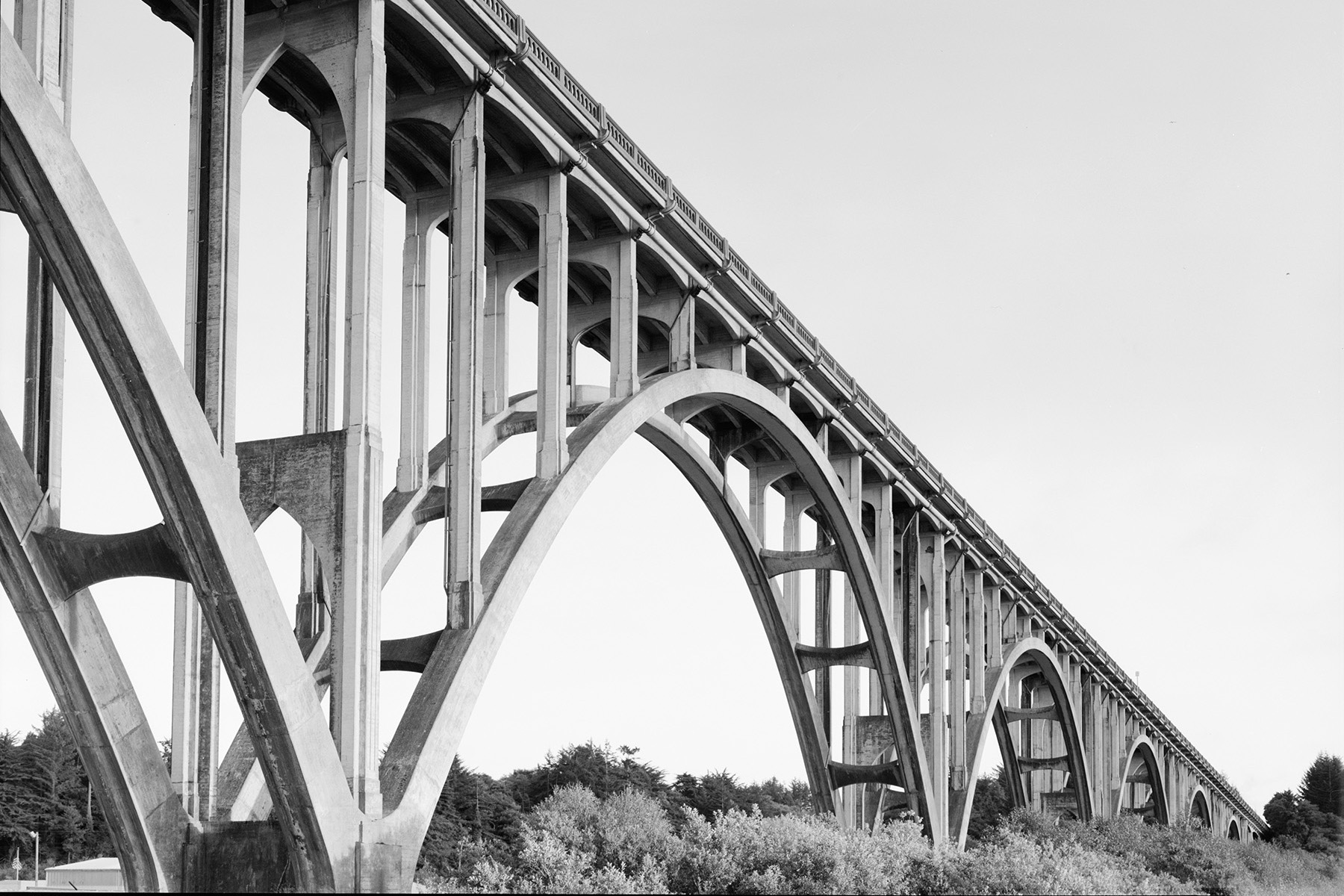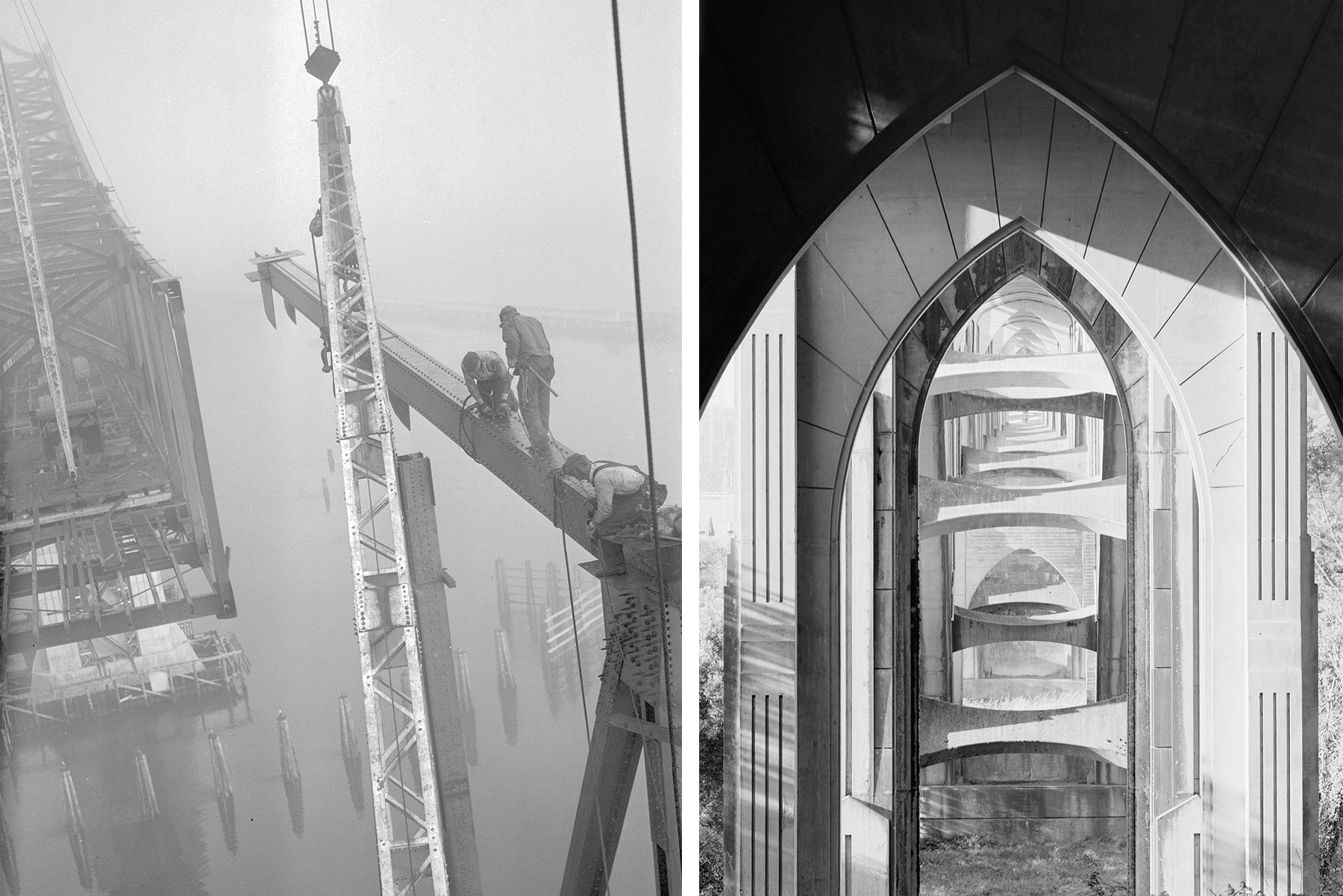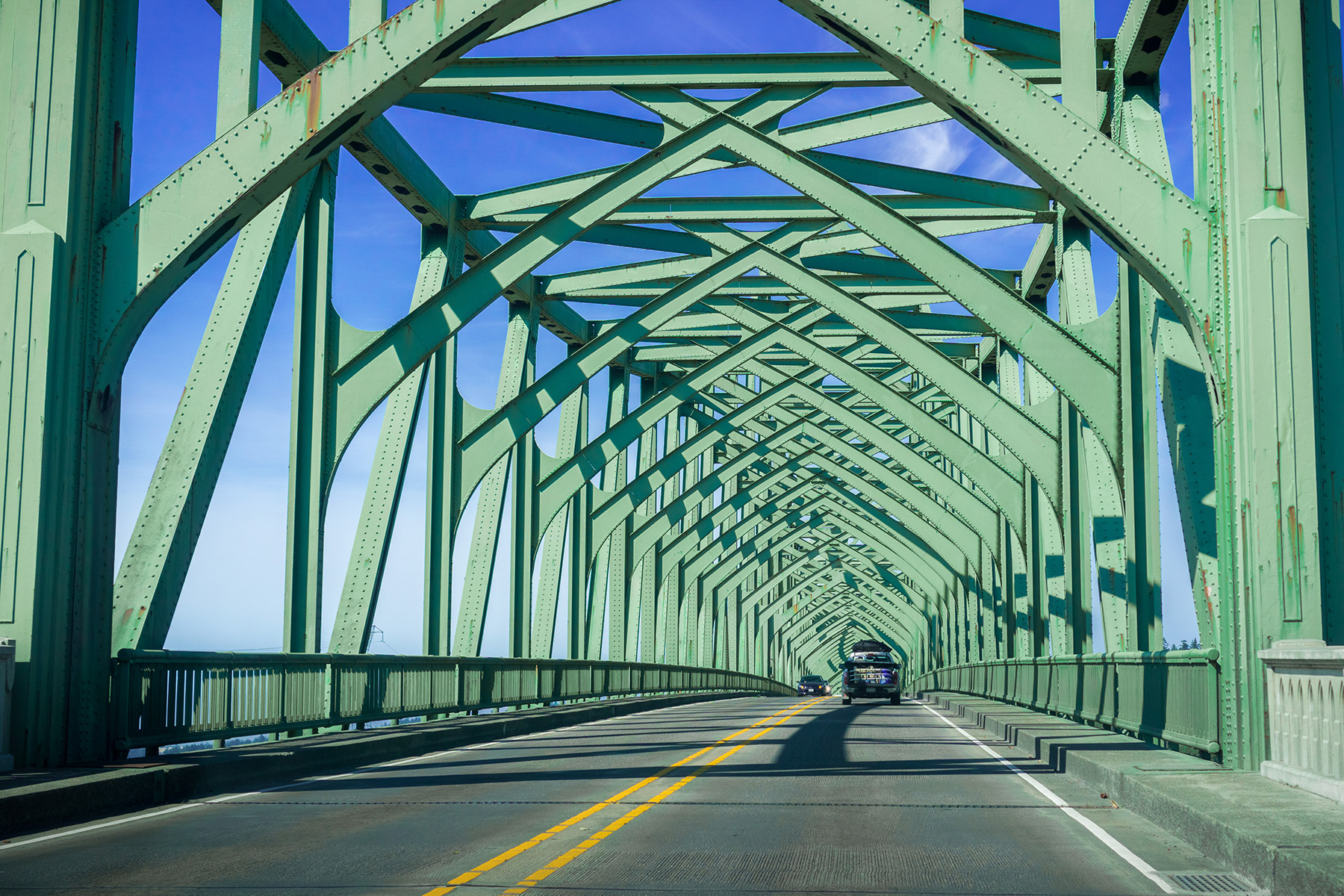
By Leslie Nemo
When the Oregon Coast Highway opened in 1932, it promised residents a smooth and scenic ride down the entire western edge of the state. Unfortunately, there were some glaring issues with this promise: three rivers and three bays that the highway did not cross. The largest of those bodies of water was Coos Bay, about 220 mi southwest of Portland.
The problem at this particular site was resolved in 1936 with the completion of the Coos Bay Bridge. One of five bridges built simultaneously along the Oregon Coast Highway, it was the longest span — stretching 5,305 ft — and the most expensive of the group to build. Its scale also made it the largest representation of the design and construction philosophies of state bridge engineer Conde Balcom McCullough, M.ASCE, and an ASCE Notable Civil Engineer.*
Long before McCullough’s bridges appeared, Oregon residents recognized the utility and beauty of their state’s coastline. Since at least the 1880s, bays along the coast had served as shipping centers for the logging industry, and by the end of World War I, locals realized that the dramatic cliffside views might attract tourists. Both industries realized that they could be better served if there were a quality road along the coast.
In 1919, voters approved legislation to allow construction of the Roosevelt Coast Military Highway (predecessor of the Oregon Coast Highway), which would run from the port city of Astoria, Oregon (at the mouth of the Columbia River), to the California state line. The road was meant to be built and operated by the federal government as part of a defense network, but that funding would never arrive. Instead, the Oregon State Highway Commission made an important choice that year to fill the funding hole: It started a one-cent-per-gallon gas tax, the first in the nation. Another notable decision that year was hiring McCullough as the Oregon State Highway Department bridge engineer.
For about the next decade, the highway commission pieced together the roadway with individual sections of grading and paving. Where needed, McCullough designed small bridges to connect these stretches with the help of his colleagues — men he recruited from his alma mater, Iowa State University, or from Oregon Agricultural College, the predecessor to Oregon State University and where he served as a professor of civil engineering. Ultimately, he and his “bridge team” would be responsible for the design and construction of more than 160 bridges statewide.

As the years passed, McCullough started to believe that structures should be beautiful. By the mid-1920s, his reinforced-concrete structures were more and more likely to showcase classical design elements such as decorative brackets on a road deck or pylons with shapes reminiscent of obelisks, wrote Robert W. Hadlow in the article “The Engineer and Oregon’s Bridge-Building Boom, 1919-1936” (The Pacific Northwest Quarterly, January 1991).
The aesthetic elements, McCullough believed, were crucial for bridges that people would see all the time and from many angles. “If the alignment is such that the structure is plainly visible in side elevation from the approaching highway, more attention should naturally be paid to a type selection which gives a pleasing side elevation outline than if only the roadway were ordinarily visible,” McCullough wrote in his textbook, Economics of Highway Bridge Types, published in 1929. “Furthermore, the natural scenic setting will play a large part in determining the extent to which considerations of aesthetics should be allowed to influence type selection.”
Crews had built McCullough’s beautiful bridges in all but five places when the highway — then known as U.S. Highway 101 at the federal level and renamed the Oregon Coast Highway at the state level in February 1931 — opened on May 28, 1932. The Umpqua River and the Siuslaw River, along with three bays —Yaquina Bay, Alsea Bay, and Coos Bay — were of such size that the highway commission struggled to gather funding to build a bridge for each location. With the Great Depression in full swing and state budgets shrinking as a result, Oregonians had to rely on ferries to shuttle them across the five waterways.
Rumors of the soon-to-be-formed Public Works Administration (part of President Franklin Delano Roosevelt’s New Deal), however, convinced the OSHD that the program could be an opportunity to get the bridges funded. Authorized in June 1933 by the National Industrial Recovery Act, the PWA ultimately doled out $4 billion for buildings and transit infrastructure and other projects. From the perspective of the OSHD, Oregon would be vying with other states for access to the coming funds, and any path to federal financing for bridges would face an extra barrier of earning approval from the War Department.
The OSHD gave itself 90 days to develop and file bridge plans that would include multiple designs per site, in the hope that at least one would pass inspection. To meet the deadline, McCullough hired enough draftsmen — legend has it he used his OAC students to swell the ranks — to have two teams each working a shift a day, either from 6 a.m. to 3 p.m. or 3 p.m. to midnight. The highway department submitted its plans to the PWA’s Oregon office two weeks ahead of schedule.
The concrete-and-steel designs McCullough and his team sent to federal agencies at first disappointed the local lumber industry. The sector had been struggling economically since the late 1920s, and by 1931 most mills throughout the state were operating at less than half their capacity, so communities and companies had hoped that wooden bridges would support a business sector so central to Oregon’s economy.
Lumber associations and local communities were mollified only when the OSHD explained that the War Department would not approve wooden structures and that there would be an estimated 10 million board-feet of lumber needed for falsework and forms, according to a National Register of Historic Places documentation form about the coastal bridges.
OSHD received the final confirmation that all federal agencies had approved funding for the five bridges on January 6, 1934. The PWA authorized $5.1 million, 30% of which was a grant. The other 70% was originally a loan to be paid back with toll revenue, but Oregon lawmakers revised the plan to use long-term obligation bonds.
Construction on all five bridges had begun by August 1934. At Coos Bay, workers began building the intended structure on July 10. It would be a “steel continuous cantilever (through) truss with bracing above and below deck,” according to the Historic American Engineering Record report on the project. The steel truss, which is 1,708 ft long, has two 457.5 ft anchors on either side of a 793 ft span.
On the north side of the steel truss are seven reinforced-concrete deck-arch spans with open spandrels, while six more are found on the south end. These 13 spans vary in length from 151 ft to 265 ft, totaling 2,761 ft. The approaches to the deck-arch spans are reinforced-concrete deck-girder spans: nine to the north and five to the south, totaling 835 ft, according to HAER. “The wide bay and the requirements of high shipping clearance made this type of bridge construction the only kind practicable,” per the NRHP document, ultimately providing 145 ft of clearance at the center.

To build the two primary piers that support the 793 ft span, workers drove 608 piles per pier to approximately “35 ft below the bottom of the pier footings,” per the July 1936 Western Construction News article “Cantilever Erection Plan Is Feature of Coos Bay Bridge.” Pile driving was made possible by “the usual method of open cofferdam construction with steel sheet piling.” These foundation piles were extended through the 43 ft by 90 ft by 8 ft concrete seal placed above them.
Barges brought the towers’ steel components to the site in four sections each. These sections were assembled using a derrick that moved along a platform that was adjacent to the pier, per the HAER report. Using the platform as support, derricks hoisted the pier sections into place. “However, anchor arm construction was kept slightly ahead of cantilever construction in order to keep the structure balanced on the falsework bent,” per HAER.
The durable falsework bents were particularly useful when it came to building the cantilever span and anchor spans. Coos Bay’s bottom is composed of soft sand and muck. “Falsework to support the steel anchor arms in the conventional manner would have required long and expensive piling and high falsework,” wrote G. S. Paxson, M.ASCE, acting bridge engineer for the Oregon State Highway Commission, in the article “Constrtuction of Coast Highway Bridges” (Civil Engineering, October 1936). Paxson would serve as supervising engineer for construction of the Coos Bay Bridge during McCullough’s absence.
Instead, crews turned to guy derricks on the temporary platform to assemble the bottom chords and floor systems of the bridge extending from the piers to the shore. Assembly stretched as far as the bent, at which point crews brought the derricks up to the deck. From there, the cantilever and anchor materials were assembled at the same time, with progress on the cantilevers inching toward the inner bay and additions on the cantilevers progressing toward the shore.
The balancing act of erecting both sides of each pier required the anchor arms to have a slightly heavier load than the cantilever sections, wrote McCullough in the article “Remarkable Series of Bridges on Oregon Coast Highway” (Engineering News-Record, November 14, 1935). Hydraulic jacks placed on the bents kept the loads balanced.

To build the arches, McCullough turned to a technique he had tried out on some of his earlier Oregon bridges. The reinforced-concrete curves reduced bending stresses on the arch ribs using a technique developed by French engineer Armand Considère. At three locations on each arch rib, “Considère hinges” were installed: two metal pieces that dip in the center, creating “hourglass-shaped articulation points,” as described by Ray Bottenberg, state bridge engineer at the Oregon Department of Transportation, in the Spring 2010 ASPIRE magazine article “Concrete Bridges in Oregon.”
The hinges were meant to support loads but allow some flexibility during construction. Workers welded the reinforcing steel only at the hinges and completed placing the concrete once the dead load was in place and falsework removed.
Because so much of the land near the Oregon Coast Highway includes sand dunes, forests, and other lush landscapes that the state had begun to designate as state parks in the early 1930s, McCullough’s aesthetic philosophies for the bridges shaped their design. “The underneath portions will be subjected to view to a much greater extent than otherwise,” he wrote in the November 1935 Engineering News-Record article.
Not only were the top and bottom chords of the Coos Bay Bridge curved, but Gothic design elements appeared in a few places, like the cut-away web walls connecting the columns on the underside of the structure and cross-bracing above the roadway that “gives the effect of a Gothic cathedral corridor,” according to the July 1936 Western Construction News article.
As a final touch, McCullough had all the steel painted a light green, a color that matched what a commissioned artist chose when painting another McCullough bridge years earlier.

Coos Bay Bridge officially opened to traffic on May 9, 1936, and was completed in September of the same year. Its construction required “5 million board feet of lumber for falsework, 51,000 cu (yd) of concrete, 3,635 tons of structural steel, and 2,205 tons of reinforcing steel,” according to the HAER report. Construction employed 250 workers per week. Earning 50 or 75 cents per hour, depending on their experience, laborers capped their time at 30 hours a week to maximize the number of people employed on the whole project.
Even more working time was squeezed out of the endeavor, per PWA requirements, by choosing some construction methods that required more labor, such as using handsaws instead of power saws to cut the formwork and wheelbarrows rather than mechanized buckets to transport wet concrete, per the NRHP document.
Despite overseeing the bridge’s development and specifying details down to the paint color, McCullough was absent for much of its construction. The engineer had taken a leave of absence and was gone from December 1935 to the spring of 1937 to work on the Inter-American Highway (between Mexico and Panama), part of the larger Pan-American Highway. When he came home, the Highway Department assigned McCullough a slightly different position, one that meant he had a less direct hand in designing bridges, Hadlow wrote.
For the last decade or so of his career, McCullough also focused on engineering law, earning his law degree in 1928 and subsequently being admitted to the Oregon bar. He co-authored the book The Engineer at Law: A Resume of Modern Engineering Jurisprudence with his son, joining the long list of other publications McCullough worked on that showcased his comprehensive approach to bridge construction. He wrote about not just bridge aesthetics and engineering theory but also financing for structures and highway departments, too. And in cases like the Coos Bay Bridge, the final products showed what could happen when design and construction kept everyone in mind: The cars driving over it, the ships sailing beneath it, the workers who built it, and the people who just wanted to look at it.
McCullough died in on May 6, 1946, and the following year Oregon renamed it the Conde B. McCullough Memorial Bridge.
Leslie Nemo is a journalist based in Brooklyn, New York, who writes about science, culture, and the environment.
This article first appeared in the November/December 2025 issue of Civil Engineering as “Crossing the Bay.”
*Conde B. McCullough, M.ASCE, has been given the designation of Notable Civil Engineer by the ASCE History and Heritage Committee. “These historic civil engineers used their creativity and ingenuity to lead the way to innovative civil engineering design, serving as an inspiration for today’s practitioners,” per the ASCE website. To find out more about McCullough and the other NCEs, visit www.asce.org/about-civil-engineering/history-and-heritage/notable-civil-engineers.
To learn more about civil engineering history and ASCE’s Historic Civil Engineering Landmark Program, visit the Historic Landmarks page.



